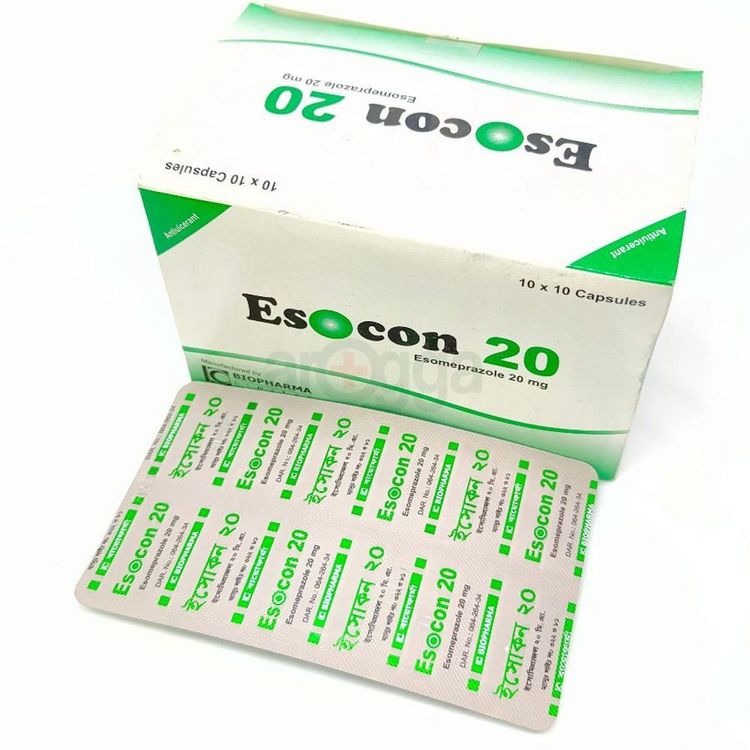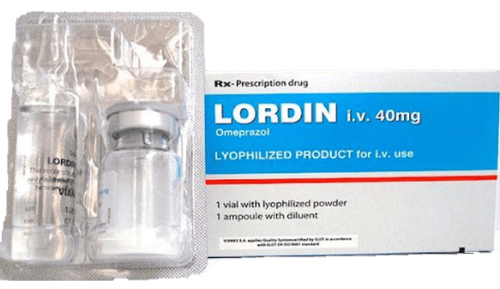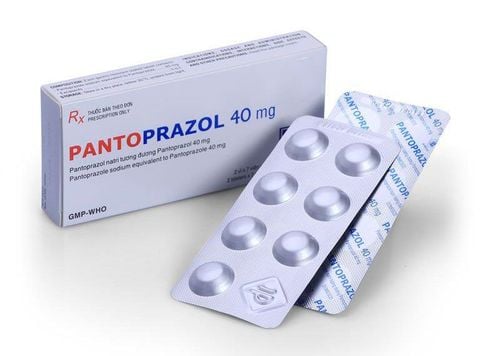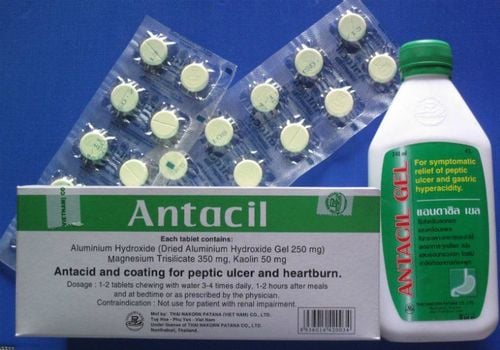This is an automatically translated article.
Esocon contains the active ingredient Esomeprazole, indicated in the treatment of gastric ulcers caused by the use of non-steroidal anti-inflammatory drugs (NSAIDs), heartburn and other symptoms caused by gastroesophageal reflux... Learn about the uses and notes when using Esocon through the article below.
1. Uses of Esocon
1.1. Indications for the use of Esocon Esocon Esocon contains the active ingredient Esomeprazole - belongs to the group of antacids, is prepared in two strengths of 20mg and 40mg. The drug is indicated in the following pathological cases:
Treatment of stomach ulcers caused by the use of non-steroidal anti-inflammatory drugs (NSAIDs); Prophylaxis of the risk of peptic ulcer disease caused by the use of NSAIDs in high-risk patients; Treat heartburn and other symptoms caused by gastroesophageal reflux disease (GERD); Treatment and healing of the lesions of erosive esophagitis; Treatment of stomach ulcers caused by H.Pylori infection when used in combination with Clarithromycin and Amoxicillin. 1.2. Pharmacodynamics Active ingredient Esomeprazole is the S-isomer of Omeprazole. The drug works to reduce gastric acid secretion by a specific mechanism of action. The mechanism of action of Esomeprazole is to inhibit the acid pump of the parietal cells of the stomach. This effect is similar for both the S-isomer and the R-isomer of omeprazole.
- Site of action and mechanism of action: Esomeprazole is a weak base. After oral administration, it will be converted to the active form in the highly acidic environment in the urinary tract and secreted in parietal cells. Here, Esomeprazole inhibits the enzyme H + - ATPase (acid pump), and inhibits both basal and stimulated secretions.
- Effects on gastric secretion: Esomeprazole 20mg once a day for 5 days will effectively reduce 90% of the maximum secretion of gastric juice (measured at 6-7 hours after the dose). medication on day 5). After 5 days of Esomeprazole administration, pH > 4 was maintained for an average of 13 and 17 hours over a 24-hour period in patients with symptomatic gastroesophageal reflux disease. The proportion of patients maintaining gastric pH > 4 at least for 8, 12 and 16 hours was 76%, 54% and 24% for 20mg and 97%, 92% and 56% for drugs, respectively. 40mg content.
- Therapeutic effect of acid secretion inhibition: Using a dose of 40mg Esomeprazole showed that 78% of patients with reflux esophagitis were cured after 8 weeks. For patients infected with H.Pylori treated with 20mg of Esomeprazole (dose twice a day) in combination with antibiotic treatment for 1 week, it was effective in eradicating HP successfully in about 90% of patients.
- Other effects related to inhibition of acid secretion: During treatment with Esomeprazole in particular and anti-acid drugs in general, it was shown that serum gastrin levels increased in response to a decrease in gastric acid. The increased ELC cell count was explained by increased serum gastrin levels (which have been observed in some patients on prolonged treatment with esomeprazole).

Thuốc Esocon được chỉ định trong điều trị loét dạ dày
1.3. Pharmacokinetics - Absorption: Esomeprazole is easily degraded in an acidic environment, so it should be prepared in the form of an enteric-coated bag. The drug is rapidly absorbed and peak plasma concentrations are reached 1 to 2 hours after oral administration. The absolute bioavailability of the drug is about 64% after a single 40 mg dose and increases to about 89% after repeated once-daily dosing. For drugs with 20mg content, the above parameters are 50% and 68%, respectively. In which food slows down the absorption of Esomeprazole.
- Distribution process: The volume of distribution of Esomeprazole in healthy subjects is about 0.22 l/kg. The drug is strongly bound to plasma proteins (about 97%).
- Metabolism: Esomeprazole is completely metabolized by the P450 enzyme system, the main metabolites are desmetryl and hydroxyl of Esomeprazole. In addition, metabolism forms esomeprazole sodium sulphone (major plasma metabolite).
- Elimination process: The drug's metabolites do not affect gastric acid secretion, about 80% of the dose of Esomeprazole is excreted as metabolites in the urine, the rest is excreted. through feces. Approximately less than 1% of an unchanged dose was recovered in the urine.
2. Dosage of Esocon
Dosage of Esocon 20mg, 40mg depends on the age and condition of the patient. Specifically as follows:
People with gastroesophageal reflux disease (GERD): The usual dose is 40 mg/day for 4 weeks. In case of symptoms, the drug can be used for an additional 4 weeks of treatment; People with erosive esophagitis: Use 20-40mg x 1 time/day for 4-8 weeks to help heal the lesions. In case the lesions have not completely healed after 8 weeks, the doctor may consider an additional dose of 4 - 8 weeks with a maintenance dose to help heal the lesions (20 mg / time x 1 time / day). ; People with duodenal ulcer: Use Esocon as part of therapy in the complete cure of ulcers caused by HP bacteria. The recommended dose is 20 mg twice daily in combination with clarithromycin and amoxicillin.
3. Side effects when using Esocon
Some drug side effects may be encountered when using Esocon 40mg, 20mg drugs as follows:
Common side effects: Diarrhea, nausea, vomiting, dizziness, headache, skin rash. Rare side effects: Irregular heartbeat, nervousness, cramps, muscle pain, fluid retention, weakness. In case of experiencing side effects while taking the drug, the patient should stop using it and notify the doctor or go to the nearest medical facility for timely treatment.
4. Note when using Esocon 4.1. Contraindications Contraindicated to use the drug in patients allergic to any component of the drug Esocon.
Use caution in patients using Esocon who develop symptoms such as recurrent vomiting, unintentional significant weight loss, vomiting blood, difficulty swallowing or black blood in stools, suspected gastric ulcer and It is necessary to exclude the possibility of gastric cancer because treatment with esmeprazole can mask the symptoms of the disease, delaying the diagnosis.

Tác dụng phụ khi sử dụng thuốc Esocon là tiêu chảy
4.2. Precautions for use - Pregnant women: There are no specific and controlled studies on the use of esomeprazole in pregnant women. Therefore, only use the drug in pregnant women when absolutely necessary.- Women who are breastfeeding: The drug is likely to be excreted in breast milk, so Esocon should only be used in women who are breastfeeding. when really needed. It is best to discontinue breast-feeding during drug treatment.
5. Drug interactions
Esocon works by inhibiting gastric acid secretion, so it can prevent the absorption of drugs where gastric pH is an important factor for drug bioavailability such as iron salts, ketoconazole, digoxin.Esocon drugs do not cause clinical interactions with Warfarin, Phenytoin, Clarithromycin, Quinidine or Amoxicillin, Diazepam, oral contraceptives... these drugs do not change the pharmacokinetic properties of Esocon.
In summary, Esocon is indicated in the treatment of stomach ulcers, heartburn, acid reflux, etc. To ensure safety and effectiveness, when using Esocon, you need to follow the indications. of the treating physician.
Please dial HOTLINE for more information or register for an appointment HERE. Download MyVinmec app to make appointments faster and to manage your bookings easily.













